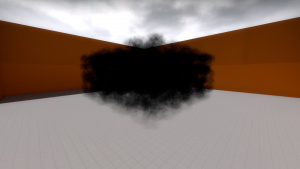func_smokevolume
func_smokevolume is a brush entity available in all ![]() Source games.
Source games.
Entity description
A brush entity that spawns smoke particles within its volume, commonly used for large, localised areas of fog. Use the trigger texture or the fog texture.
particle/smoke_grenade1, which does not exist. However, particle/particle_smokegrenade does.Keyvalues
- Particle Color1 (R G B)
(Color1)<color255> - How dim particles can be.
- Particle Color2 (R G B)
(Color2)<color255> - How bright particles can be.
- Material
(material)<material> - The material to use for the particles
- Particle Draw Width (units)
(ParticleDrawWidth)<float> - The size of the particles, in units/inches. (Typical Values: 128,175,200,500,512)
- Particle Spacing Distance (units)
(ParticleSpacingDistance)<float> - The distance between the particles inside the volume. The lower the number, the denser the particles, and the more overdraw there will be. It is best to keep it as high as you can without it looking bad. (Typical Values: 125,150,200 and sometimes 80 or 480)
- Density Ramp Speed (seconds)
(DensityRampSpeed)<float> - Time to go from density 0 to density 1, in seconds.
- Rotation Speed (degrees/sec)
(RotationSpeed)<float> - The speed that the particles should rotate, in degrees per second. (Typical Values: 3,10)
- Movement Speed (units/sec)
(MovementSpeed)<float> - The speed that the particles should move around, in units/inches per second.
- Density [0..1]
(Density)<float> - Particle density, from 0 to 1. (Typical Values: .1-.5)
- Max Draw Distance (0 is unlimited)
(MaxDrawDistance)<float>
- Name
(targetname)<string> - The name that other entities refer to this entity by, via Inputs/Outputs or other keyvalues (e.g.
parentnameortarget).
Also displayed in Hammer's 2D views and Entity Report.See also: Generic Keyvalues, Inputs and Outputs available to all entities
Flags
- 1 : Emissive
- Makes sprites render fullbright. Normally the brightness is affected by light nearby.
Inputs
SetRotationSpeed<float>- Set the particle rotation speed (in degrees per second).
SetMovementSpeed<float>- Set the particle movement speed (in inches per second).
SetDensity<float>- Set the particle density. It should be a range from 0 to 1.
